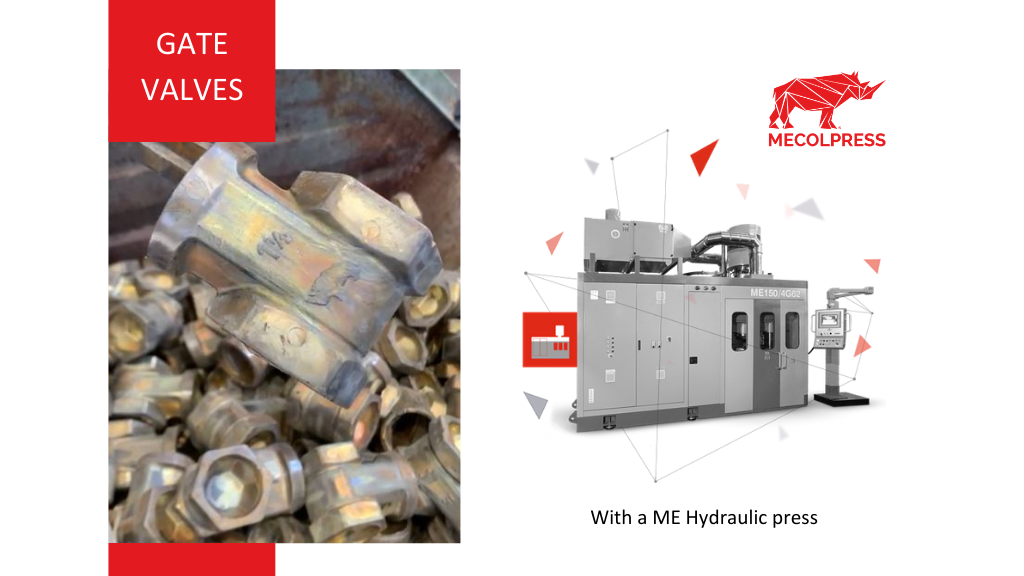
Forge gate valves with a ME Hydraulic press!
In this video you can see the hot forging of gate valves with a ME hydraulic press.
Go beyond the normal criticality of the forging of these valves, get a piece without flash and reduce production costs.
What are gate valves and how they are traditionally forged?
The brass or other materials gate valves have the function of fluid flow adjusting and stopping onto a tube. They fulfil this control through a hand wheel (or a motorized actuator).
To give you an idea, you can compare the function of the mentioned valve to the closing of a gate slide in the middle of a tunnel flooded by the water.
Usually the gate valves are hot forged through traditional eccentric mechanical presses, but their realization is not easy, above all if you want to forge the part without possible defects, using little material (therefore with the most possible depth of all the holes) or without flash as well.
The traditional forging of gate valves by means of eccentric mechanical presses requires a greater energy compared to the one necessary for forging of ball valves having the same dimensions, and it requires a much higher punches stroke, in particular for one of them.
For example, for the realization of gate valves of 2 inches or more, eccentric mechanical presses of minimum 450 tons capacity and a forging tool (defined as bell tool) that allows the realization of holes of great diameter are normally used.
This technology has been valid and successfully used for many years, and Mecolpress as well proposes it to its customers through its SEO and SEO CVE CS presses series.
Gate valves forged by means of hydraulic presses
There is also a much more efficient way for gate valves hot forging: ME hydraulic press.
ME hydraulic presses, in fact, thanks to the different working dynamics of the punches, are proving to be really decisive for all the forgings of more “problematic” and complex parts, consenting for example to avoid the use of EV bell tool.
As we show in this video by means of ME presses you can forge high quality gate valves, without flash, detail of great importance. The presence of flash in the forged parts implicates a considerable waste of material, and moreover, to remove it, it is necessary to use a trimming press, which means therefore that you will have to equip yourself with an additional machine.
Another interesting aspect to be underlined is the fact that hydraulic presses have a cycle frequency significantly higher than normal mechanical presses.
Our ME hydraulic presses have also as standard equipment the Calipso software, our innovative program for collecting and checking forging data. Through this intelligent system you can perform analyses of the production process, but not only! In fact, it is possible to obtain an optimal and separate management of any pieces to be discarded or otherwise to be evaluated.
The checking of the pieces carried out by Calipso guarantees the certified quality of each piece produced.
Another important advantage that is standard on our ME hydraulic presses is the innovative die lubrication system, that can also be optionally applied to eccentric continuous cycle presses. In hot forging it is important not to underestimate the way in which the dies are lubricated; finding the “perfect” lubrication in your forging process ensures an increase in the life of the dies and materials unattainable with traditional systems!
The ME hydraulic press has an innovative forging system compared to traditional mechanical presses. Innovative because, for example, it does not generate mechanical shocks, it considerably reduces the noise generated during production, the tooling is much faster and more convenient.
Here is the video of the forged gate valves with ME hydraulic press:
The advantages of using hydraulic presses in gate valves hot forging
In summary, why should you choose a hydraulic press to forge gate valves?
- No bell EV tool,
- Gate valve without flash,
- Forged pieces controlled by the powerful Calipso software,
- Separate management of non-compliant parts,
- Better forging lubrication system,
- No mechanical shock,
- Less noise,
- More setup speed.
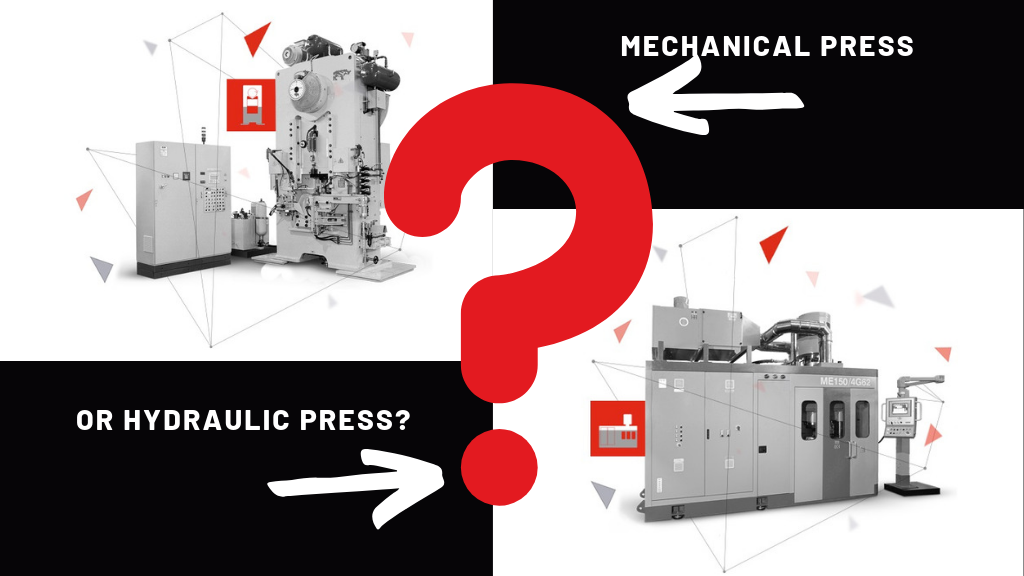
Mechanical press or hydraulic press?
Thanks to the long experience as press manufacturers, Mecolpress can offer to its customers a wide choice of mechanical and hydraulic presses for hot forging and our sales department team can suggest the most suitable machine for the realization of a specific geometry.
Differences between mechanical press and hydraulic press
The mechanic press develops the movements necessary for forging thanks to mechanical connections between the ram and the horizontal coring system of the parts. The upper die close against the lower one and the punches enter laterally. The movements of the mechanical components are therefore all connected with each other and their planning results to be a little bit restricted because if you adjust the movement of a component, you will automatically modify the other ones, as well.
The movements of the components of the hydraulic press are adjusted by hydraulic cylinders instead and you will have an independent control on each axis. This implicates a superior programming flexibility because you can operate on the single components and obtain a better material flow management inside the die.
When it is better to choose a mechanical press
The mechanical at continuous cycle presses for metals hot forging have a higher productivity compared to the hydraulic presses, and this certainly represents an advantage.
There are vertical forged parts, such as the straight junctions or the nuts, that due to their shape are very suitable to be forged by high productivity mechanical presses.
When it is better to choose a hydraulic press
The hydraulic presses allow a major control on the movements of the single components and are more suitable for the realization of parts of complex geometry, such as the slide gate valves. The punches that contribute to the realization of the part are indeed independent and are generally four, placed at 90° of distance from each other, but one or even two punches can be set up with a variable angle of entry, for example of 45° compared to the adjacent one. This implicates a higher flexibility and the possibility to realize some very complex shapes maintaining a high-quality standard.
Another characteristic of hydraulic presses for metals hot forging is the fact that they need less structure inside the productive area because they do not need to be placed on a pit, that is compulsory for the mechanical presses. The positioning of the hydraulic press on simple floor allows a higher flexibility in the factory layout.
The best choice? Ask Mecolpress!
The choice to buy a mechanical or a hydraulic press is almost exclusively made based on the shape of the part to be forged and not based on the material. Both the presses typology forge indeed different types of metals. The only case in which the material can be a decisive factor refers to steel productions that often require the use of a screw press because of the high tonnage.
Mecolpress offers excellent mechanical and hydraulic presses according to the part geometry that the customer wants to realize, and suggests the best and most performing press, that can indeed optimize the production and sparing on the costs.
If you want to receive information regarding our hot forging presses, you can write to: sales@mecolpress.com
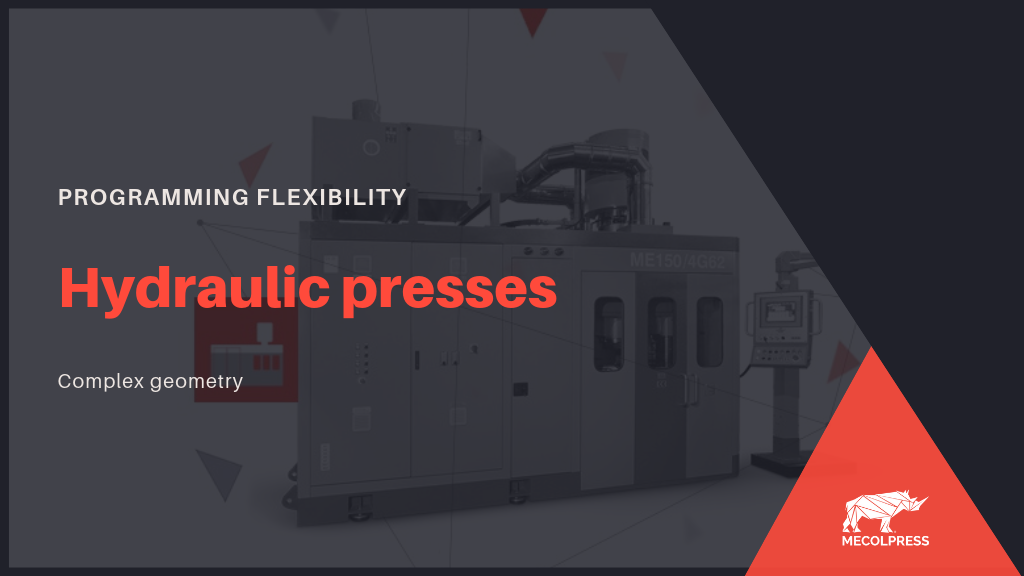
Mecolpress hydraulic presses: features and advantages
Mecolpress boasts a wide range of hydraulic presses of different tonnages, ideal for the realization of hot forged parts with complex geometry. The presses are equipped with a Mecolpress proprietary software, “Calipso”, that allows to monitor the entire productive cycle of the hydraulic press according to numerous parameters.
Features of hydraulic presses
Hallmark of every hydraulic press is the programming flexibility. Since the ram and the punches are independently controlled by hydraulic cylinders, this allows to carry out some corrections during the working cycle to remedy some eventual defects by acting on the movement of a single component through software.
Hydraulic presses can hot forge different materials including brass, copper, aluminum, steel and titanium alloys.
Range of Mecolpress hydraulic presses
Mecolpress offers to its customers a wide range of presses with a die closing force that currently goes from 100 to 500 tons and a minimum punch force of 30 tons that can arrive till 350 tons.
Moreover, our hydraulic presses are provided with a loading arm for warm billets and with an unloading arm for the forged part. Based on the customer’s needs concerning the layout for the hot forging production line, the arms can be placed on the same side and working in sync, otherwise placed on the opposite sides and working autonomously. Thanks to “Calipso” software developed by Mecolpress and installed on every hydraulic press, the press can detect which parts are not in compliance with the programmed parameters, and these parts will be automatically separated from the others by the unloading arm, flowing into a box for wastes.
This management allows to optimize the checks and to save time on the productive cycle.
Possible configurations of a hydraulic press
Mecolpress hydraulic presses can be set up in a custom-made way according to production needs expressed by the customer. For example, one or two punches can be placed with an entry angle different from the classic 90°, allowing the realization of particularly complex shapes such as, for example, Y-junctions and filter bodies.
Further possible configurations are:
- the addition of a fifth vertical punchthat operates under the die,
- the loading of one or two billets at the same time till a maximum of four,
- the addition of pyrometers for billet temperature detection,
- the application of extra sensors on the punches for both physical and mechanical data collection that are then sent to the PLC and that allow to better monitor the production cycle.
Indeed, the sensors always check the movement carried out by the punches during the stroke and it is possible to obtain a representation of the different acceleration and deceleration phases. This real time analysis allows to notice eventual problems and to understand if these derive, for example, from the die or if these are of hydraulic or mechanical type.
In this way also the Mecolpress service team can intervene in a more to the point and prompter way, reducing the machine stop costs.

Gate valves hot forging: Mecolpress solution
Gate valves hot forging can present some criticalities. Mecolpress hydraulic presses could brilliantly overcome these, reducing production costs and consenting to obtain a forged part without flash.
Function and features of gate valves
The most commonly hot forged brass parts are the ones used for the liquids control.
The parts can be, for example:
- water meters bodies,
- ball valves,
- water and gas fittings,
- gate valves.
These latter ones have the function of fluid flow adjusting and stopping onto a tube and they fulfill it by controlling through an handwheel (or a motorized actuator) the interposition of a disc between the in- and out- sections of the valve. In order to better visualize their movement, you can image it like the closing of a gate slide in the middle of a tunnel.
Also depending on application typology, every manufacturer develops his own drawing for valves that are characterized by contours, dimensions and always different thicknesses.
The range of measures of the valve is very wide. These measures are usually defined in inches and are related to the useful section of fluid passage when the valve is totally open.
Also the working pressures, the valve control and the working environment determine the need to have valves with hose joints that are more or less distant from the valve center, with circular section neck valve o irregular hexagon section neck valve, with greater of minor neck height.
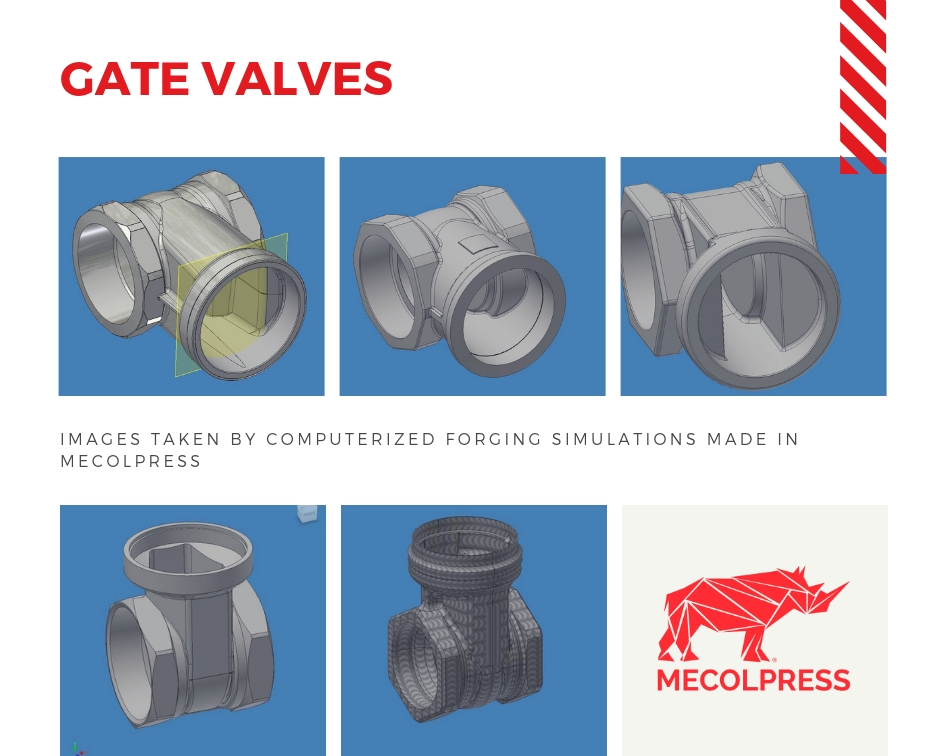
Hot forging by means of eccentrical mechanical press
Normally the hot forging of a gate valve is not very easy to realize, above all if you want to forge the part without possible defects, using little material (therefore with most possible depth of all the holes) or without flash as well.
The traditional forging with eccentric mechanical presses of gate valves requires a greater energy compared to the forging of ball valves having the same dimensions, and a punches stroke, in particular of one, much higher.
For example, for the realization of gate valves of 2 inches or more, eccentric mechanical presses of minimum 450 tons capacity and a forging tool (defined as bell tool) that allows the realization of holes of great diameter are normally used.
This technology has been valid and successfully used for many years, and Mecolpress as well proposes it to its customers through its SEO and SEO CVE CS presses series.
But there is also a much more efficient way for gate valves hot forging: the hydraulic press.
Forging by means of hydraulic press
Gate valves can be hot forged even by means of Mecolpress hydraulic press of ME series.
Our ME presses allow to forge these valves completely flashfree, with very high precision, without risk of defects due to the brass flow in the die.
Moreover, also the productivity is higher than the one allowed by traditional method with eccentric mechanical presses and bell tool.
An hydraulic Mecolpress press ME350-4G240, for example, can forge 2 inch gate valves flashfree, without the help of special tools, with a productivity of about 800 parts/hour.
Production optimization: a Case Study
Exactly for this application in January 2019 we supplied a hydraulic press ME350 to one of the most important valve manufacturers of Far East.
We started the collaboration with the customer by studying the “traditional” valve geometry and after the forging simulations carried out by our technical office, we could verify that some improvements connected to the shape were possible.
Indeed, the study showed that the thicknesses could be reduced and therefore it was possible to reduce the weight and the cost of the forged part. Moreover, our technicians considered useful to modify corners and corner rounding to ease the brass flow. These modifications grant a longer die duration.
Once the approval from the customer for the new geometry was obtained, we realized the die and then a sample of these valves that were sent to the customer both for dimensional checks and for mechanical machining tests.
All the tests gave successful outcome and now the customer is impatient to receive the hydraulic press and to start producing this with this new much more efficient method that will reduce considerably the necessary brass quantity to realize the hot forged valve.
Over the years Mecolpress has developed a considerable experience in gate valves hot forging field and for every valve shape, or brass alloys to be used, including, for example, brass without lead or anti-dezincification brass.
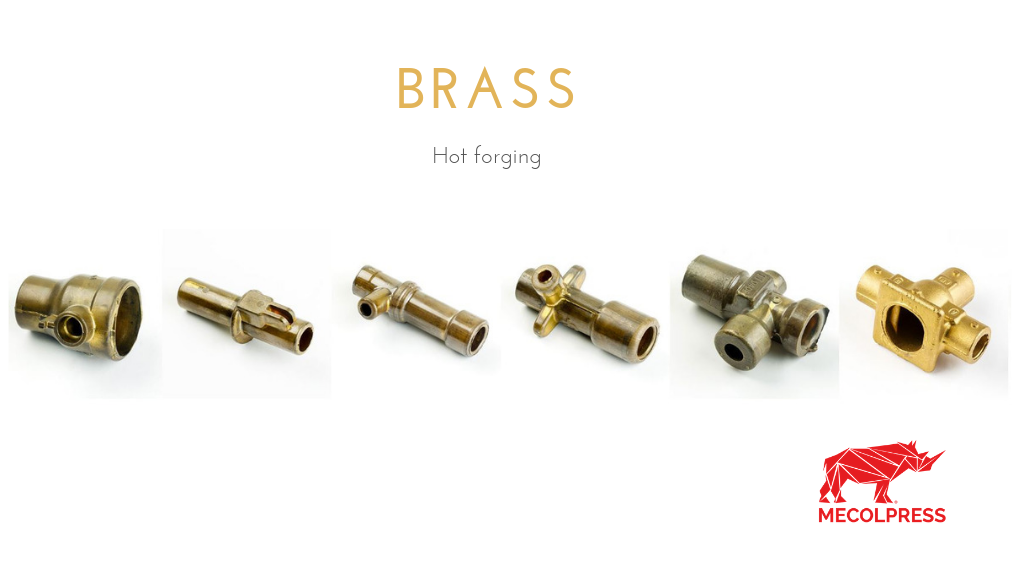
Hot forging of the brass: advantages of this material
The brass and its characteristics
The brass is an alloy composed of lead, copper, zinc and other metals, whose percentage can vary. The main component of this alloy is the copper that has a percentage between 55% and 62%. This high content of copper makes the brass a good electricity conductor and a material of easy mechanical machining because it does not wear out the cutting tools quickly as it instead happens for iron or steel.
Other typical features of the brass are:
- Recycling ease: brass is often remelt and reused to produce new parts.
- Resistance to a wide temperature range: during the hot forging process the brass is able to support, without creating particular critical issues, a moderate temperature range, this simplifies considerably the work, allowing a major tolerance in the usage of machineries.
- Lacking oxidation: During the heating phase inside the die, this metal is not subject to considerable oxidation.
- High corrosion resistance: the brass is a nonferrous alloy and therefore it does not get rusty.
Sectors of brass application
Thanks to its colour similiar to gold, the brass is used also for the realization of ornamental elements, home furnishing pieces such as for example handles and finishing for furniture, elements for clothing, including zippers and belt buckles.
Another sector of particular importance is composed by fluid control. This metal is particularly fitting for the production of valves, junction and fittings; since specific brass alloys with unimportant lead content were realized, the so produced pieces are therefore suitable to the contact with drinkable water. These special alloys are defined as Lead-free
In the end, as already underlined, the brass is a good electrical conductor and this characteristic makes him suitable for the realization of the electrical and electromechanical components, including switch parts, connections and terminals.
The hot forging process of the brass
The brass, that thanks to its particular plasticity permits to produce complicated geometrical shapes with simple processing, is hot forged as follows: when the press closes the dies with a single hit on the billet, it turns it into the part to be realized (in contrast to the steel that needs almost always a sequence of many hits). Inside the two halves of the die, that have the shape of the part to be realized, it is set down an enough quantity of metal in order to perfectly fulfill the entire cavity created by the two dies once they are overlapped and closed.
Presses for brass hot forging
For the hot forging of the brass it is possible to use continuous cycle presses or single cycle presses. The continuous cycle press is provided with a ram that moves continuously without stopping. The billets loading and the forged parts unloading is automatically adjusted by the electronic check. Instead, the single cycle press expects, at the dies reopening after a single hit, that the order for a new descent or closure of the dies must be sent by the user or by the PLC.
Mecolpress presses for the hot forging of the brass
For the hot forging of brass parts, Mecolpress proposes numerous mechanical and hydraulic presses with different characteristics according to the production typology that the customer wishes. Lately we have developed an innovative technology on our hydraulic presses for forging four parts with just a single hit that allows an important saving on the productive costs, come to discover how by reading the article!
